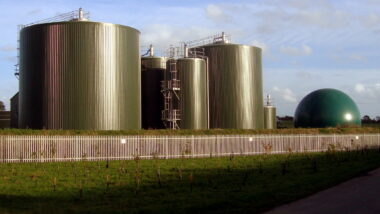Anaerobic digestion (AD) may sound rather like an uncomfortable stomach complaint. However, for most people it’s sure to be the most important renewable energy source you not heard of. AD may hold associations with manure and unpleasant smells. But, whatever your impressions might be, it is an emerging technology with enormous “green” potential. It’s a process with unique energy making properties, while it also provides a way to gain real benefits from wastes which would otherwise be a costly environmental burden to get rid of.
Anaerobic Digestion Sounds Interesting…
“O.K. sounds interesting”, you say? But, tell me all about it quickly most also say.
Now that’s quite hard to do, because AD can be done in so many ways, and has so many benefits that it’s hard to tell of them in just a few words. But, do grab a coffee, take a deep breath and read-on and see how how this article grabs you!
AD Definition
Anaerobic digestion is the natural process by which organic matter such as animal or food waste is broken down to produce biogas and biofertiliser.
It’s a collection of processes by which microorganisms break down organic (biomass) material in the absence of oxygen.
By contrast, most people know about composting. Composting is the equivalent process when oxygen is present. Just think of it as composting when there is no access for air (oxygen).
Composting is great for the soil and grows great plants, but whenever air is present no energy/ gas is produced. In fact composting is an energy consuming process. In many ways composting is the opposite of AD.
Recent Developments in AD and Biogas Production
Anaerobic digestion started to gain popularity almost 20 years ago after being almost forgotten in the UK, since it was first used at some sewage works in the 1930’s. It has quietly been being used by more and more farmers to make energy from manure, and the waste parts of their crops.
Now the use of anaerobic digestion, which creates “biogas” – a mixture of methane (about 50% – that’s the gas which comes out of your home gas pipes), carbon dioxide and water vapour, plus some impurities in much smaller (trace) amounts is entering a new phase.
A Major Avoidable Producer of Carbon Emissions is Waste Food
That’s because one major producer of carbon emissions is waste food, and the climate changing effect of food waste is significant. If the UK is serious about complying with its promises to other global nations to reduce the effects of climate change, it has to find ways of avoiding food waste carbon emissions.
In the last year anaerobic digestion has been recognised by the government, Defra, the Welsh Assembly, the Scottish Parliament, Friends of the Earth and the National Farmers Union as one of the best methods for food waste recycling and dealing with farm waste and sewage sludge. It’s far better than burning it in incinerators, because food as we all know burns very badly, if at all in normal conditions.
It’s very “wet” you say! Yes. Exactly right…
Biogas Produced by the Anaerobic Digestion Process
Anaerobic digestion produces biogas. That’s a renewable energy that can be used for heating, electricity, and many other operations. From the start it has been used to power reciprocating internal combustion engines, such as GE Jenbacher or Caterpillar gas engines to make electricity. Heating his provided at the same time, by using the engine’s cooling system heat. This heat is called CHP (combined heat and power) heat, and that is pumped in heat insulated pipes to farmhouses, barns, homes and businesses. This makes efficient use of the energy. But, more efficient uses of the biogas have now started to become more popular.
Biogas is identified by the EU among the non-fossil renewable energy sources that can provide not only self-sufficient energy, but also the gradual reduction of the current state of air pollution and thus the greenhouse effect. It also offers a renewable alternative to the consumption of fossil fuels.
The Rise of Biomethane
The air pollution produced by purified biogas (known as “biomethane”) is similar to that of natural gas. And, natural gas’s pollution of the air in VERY low. It’s a renewable source of energy that belongs to the category of biofuels.
An additional benefit of Anaerobic Digestion is that it produces a bi-product known as digestate which can be used as organic fertilizer on arable crops. Biogas is considered to be a renewable resource because its production-and-use cycle is continuous, and it generates no net carbon dioxide.
Anaerobic Digestion and Future Food Waste Management
Perhaps the biggest growth area for anaerobic digestion in UK, over the next few years will be in developing facilities for food waste management.
Food waste is a huge problem in all developed countries, and has been reaching crisis levels in the UK for a few years. Not only does it add problems to the operation of landfill sites when thrown into general waste bins, Britain’s colossal food waste is stoking climate change.
“Food waste is stoking climate change”
In terms of waste management, food waste is that kind of waste resulting from food that is thrown away. Food waste isn’t only what you and I throw away, it is any food intended for consumption that is discarded along the food supply chain and cannot be used.
However, to cut-down the carbon emissions associated with avoidable household food waste alone, by reducing transport emissions is so large that we would have to take one in four cars off UK roads.
Complying with Promises Made at the 
The issue must be tackled or the UK will fail to comply with commitments made to the rest of the world at the Paris Accord on Climate Change. And, there is already an answer to unavoidable food waste.
As alternatives to landfill, food waste can be composted to produce soil and fertilizer, fed to animals, or used to produce energy (fro example vehicle fuel), via the anaerobic digestion process with biogas production.
Major of London has Accepted that Biogas Plants are the Best!
Recently, a number of bodies including the Major of London have accepted that biogas plants are the best way to deal with unavoidable food waste. Experts believe that many more of them will be built in the coming years.
All in all, going back to our title, we think you will now agree that anaerobic digestion is important. If you have read to here, we think that you will now know a lot more about the most important renewable energy source you may never have heard of.
Author Bio: Steve Last is a waste management expert, and family man, who believes that technology is the only route available to solve man’s over-consumption of global resources. He runs the popular website https://anaerobic-digestion.com where readers can find out more on the subject of anaerobic digestion and biogas.



